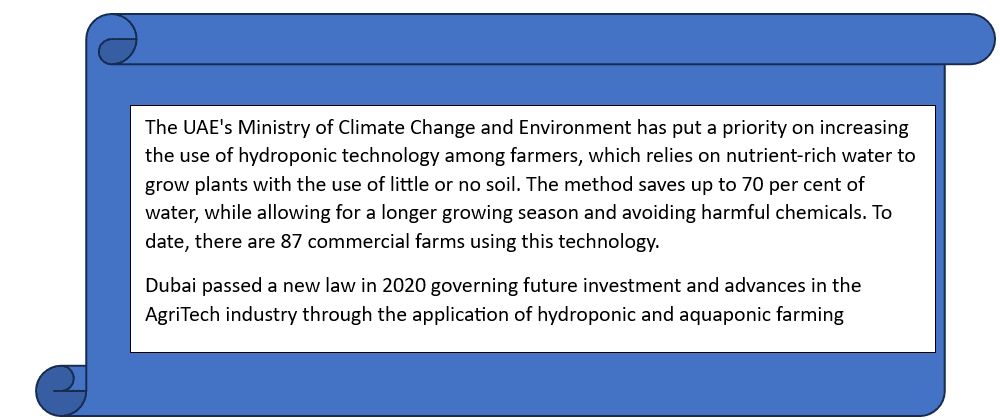- Home
- About Us
- Industry
- Services
- Reading
- Contact Us
MENA Aquaponic and Hydroponic Farming Market is Expected a Soaring 15.56% Growth by 2022, Projects UnivDatos Market Insights
Author: Himanshu Patni
December 15, 2023
According to a new report by UnivDatos Market Insights, the MENA Aquaponic and hydroponic farming Market is expected to reach USD 254.56 Million in 2022 by growing at a CAGR of 15.56%. The rising global demand for food and a rapid increase in urbanization coupled with the growing adoption of aquaponic & hydroponic farming in commercial, education, and other sectors. Majorly, the water scarcity and arid climate in MENA region hydroponics and aquaponics offer water-efficient alternatives to traditional soil-based agriculture, addressing the challenges posed by water scarcity and ability to thrive in controlled environments in the MENA region. As per the data of UN Food and Agriculture Organisation, in 2021, over 51 million people are suffering from hunger in Arab nations.Moreover, the Middle East (including North Africa) accounted for 20% of the world’s acutely food insecure people in 2020. The increasing awareness and emphasis on food security and self-sufficiency in the MENA region have spurred interest in innovative farming practices.
Access sample report (including graphs, charts, and figures) – https://univdatos.com/get-a-free-sample-form-php/?product_id=51108
The report suggests that aquaponic and hydroponic farming resources in Middle East and North Africa (MENA) region had a significant impact on the aquaponic and hydroponic farming industry in the MENA region. Some of the ways in which this impact has been felt include:
· In April 2020, Abu Dhabi Investment Office (Adio) financed USD 100 million (Dh367m) to bring four agriculture technology companies to the emirate as part of government efforts to attract high-skilled talent and cutting-edge research.
· In July 2020, Crop One Holdings and Emirates Flight Catering launched the world’s largest vertical farm in Dubai, with the capacity to produce over 2 million pounds of leafy greens annually.
· In February 2020, Silal and AeroFarms have signed a Memorandum of Understanding (MoU) to forge a long-term research and development collaboration involving knowledge and technology transfer of advanced farming systems to local farmers. AeroFarms has also signed a new collaboration agreement with Silal to focus on R&D to commercialize new crops like tomatoes and peppers.
· In November 2022, AeroFarms has announced plans to expand further in the Middle East through a partnership with QFZA and Doha Venture Capital (DVC) to build a commercial indoor vertical farm in Qatar Free Zones (QFZ).
· Saudi Arabia’s agriculture sector is highly vulnerable to drought and hot spells which are expected to be exacerbated by climate change, threatening Saudi Arabia’s food supply. In response to COVID-19, two initiatives worth a total of USD 665m were introduced to support food imports and local farmers. Part of the local production support includes loans to help cover the capital costs of hydroponics systems, which use 90% less water than traditional farming practices.
Apart from this, in recent years, several governments in the Middle East and North Africa have implemented policies and provided funding support to enhance the growth of the Aquaponic and hydroponic farming industry. Some examples include:

The UAE’s Ministry of Climate Change and Environment has put a priority on increasing the use of hydroponic technology among farmers, which relies on nutrient-rich water to grow plants with the use of little or no soil. The method saves up to 70 per cent of water, while allowing for a longer growing season and avoiding harmful chemicals. To date, there are 87 commercial farms using this technology. Dubai passed a new law in 2020 governing future investment and advances in the AgriTech industry through the application of hydroponic and aquaponic farming
For a detailed analysis of the MENA Aquaponic and Hydroponic Farming Marketbrowse through – https://univdatos.com/report/mena-aquaponic-and-hydroponic-farming-market/
Conclusion
In conclusion, aquaponic and hydroponic farming are becoming integral components of the agricultural landscape in the MENA region. These methods, driven by the necessity to overcome water scarcity and produce food sustainably, are reshaping the way we perceive and practice agriculture. The demand for locally sourced, fresh produce, coupled with the need for resource-efficient farming in arid environments, positions aquaponics and hydroponics as catalysts for a more sustainable and resilient food future in the MENA region.
Get a Callback
